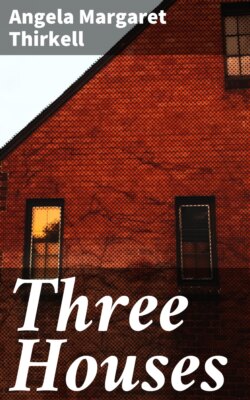Three Houses

Реклама. ООО «ЛитРес», ИНН: 7719571260.
Оглавление
Angela Margaret Thirkell. Three Houses
Three Houses
Table of Contents
Introduction. RICHARDSON’S GROTTO
Part One. THE GRANGE
Part Two. NEXT TO THE GREYHOUND
Part Three. NORTH END HOUSE
I
II
III
IV
V
VI
Отрывок из книги
Angela Margaret Thirkell
Published by Good Press, 2021
.....
As soon as we were out of the house we might have been in the country. Gardens surrounded us on all sides and only a few years earlier there had been fields behind the little orchard which bounded the further end. Ugly brick houses had been built since then, but they were hidden by the long white rough-cast studio which stood between the orchard and the road. It was called the Garden Studio, and here my grandfather worked on his larger canvases. It was a little alarming to us: the red-tiled entrance and steps which led down to the furnace-room where we were never allowed to go and anything, one felt, might live; the iron grills in the floor to let in the warm air for winter days; the tall narrow slit in the outer wall through which finished pictures were passed. Sometimes these pictures went to exhibitions, but more often straight to the friend or patron (in the very best sense of the word) who had commissioned them and was content to wait for years if need be for the perfect expression of the artist’s mind. In this studio there was a very high set of steps with a higher and lower platform on which the artist worked at the upper portions of his picture. I remember sitting on these steps, my head wrapped in a many-coloured piece of silk and bound with a coronet, while my grandfather made studies of crown and drapery for one of the mourning queens in the great unfinished picture of Arthur in Avalon which is now in the Tate Gallery. Here too he was working at the time of his death on the picture—also unfinished—of the Car of Love, now at South Kensington, where Love, standing in a great brazen chariot, is drawn through the thundering streets of some imagined city by a throng of his worshippers, some happy, some stabbed with pain, but all his slaves.
Because there is a certain likeness between the little girl who wore the coronet and some of her grandfather’s pictures, she has often been asked whether she sat to him. As far as I remember he never used me as a model except on that one occasion when I wore the crown and veil. Nor in any case could he have drawn me often, as I was not yet eight years old when he died. Neither did my mother who was pure ‘Burne-Jones type’ sit to him much. The curious thing is—and it ought to open a fresh field of inquiry into heredity—that the type which my grandfather evolved for himself was transmitted to some of his descendants. In his earlier pictures there is a reflection of my grandmother in large-eyed women of normal, or almost low stature, as against the excessively long-limbed women of his later style. But the hair of these early women is not hers, it is the hair of Rossetti’s women, the masses of thick wavy hair which we knew in ‘Aunt Janey’, the beautiful Mrs. William Morris. When I remember her, Aunt Janey’s hair was nearly white, but there were still the same masses of it, waving from head to tip. To any one who knew her, Rossetti’s pictures—with the exception of his later exaggerated types—were absolutely true. The large deep-set eyes, the full lips, the curved throat, the overshadowing hair, were all there. Even in her old age she looked like a queen as she moved about the house in long white draperies, her hands in a white muff, crowned by her glorious hair.
.....